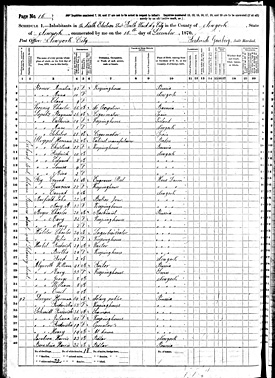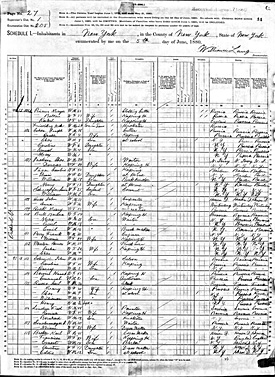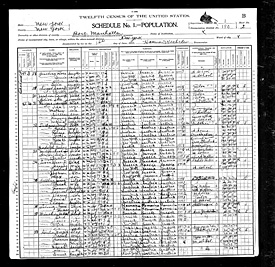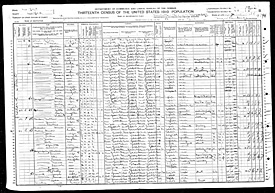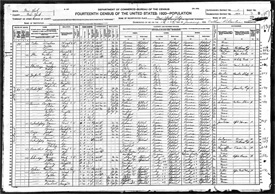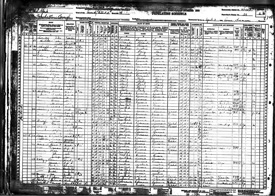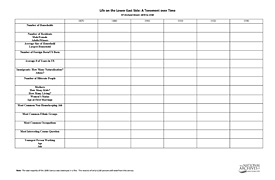
Life on the Lower East Side: A Tenement over Time
Life on the Lower East Side: A Tenement over Time
- Description
- Documents
- Learning Activity
- Discussion Questions
- Extension Activities
- Standards
- Additional Resources
- Contact Us
Description
The Lower East Side of Manhattan was (and in some ways still is) a bastion for immigrants from around the world. During the peak era of immigration at the turn of the 20th century, nearly ¾ of all immigrants that entered the United States came through the Port of New York. Many of these immigrants would begin their American journey in neighborhoods like the Lower East Side. 97 Orchard Street, now home to the Lower East Side Tenement Museum, was once home to nearly 7000 immigrants. From 1863 to 1935, immigrants from around the world first experienced America in this modest, six-story brick tenement on the Lower East Side.
Through the Census Records of the National Archives, one can trace the evolving population of this national landmark. Though merely a snapshot of a tenement at 10 year intervals, the Census records reveal a variety of details about the community of the Lower East Side.
Documents
Learning Activity
- Divide your class into 7 groups.
- Give each group a copy of the individual Census schedules for a particular year.
- Distribute comparative analysis worksheet
- Give each group 10-15 minutes to analyze their individual Census year using the comparative analysis worksheet.
- After 15 minutes, jigsaw the activity, and create new groups containing one member who is an "expert" about a particular census year.
- Note: Each group will have 1 member from the original groups and all Census years from 1870-1930 should be represented in this second group.
- Members of this second group will explain their year's Census data to other group members and fill in other parts of the comparative analysis worksheet.
- After completing the worksheet, students will discuss and analyze the changes over time and look for similarities, differences, patterns, etc to the community of 97 Orchard Street.
Note: This activity can be differentiated based on ability level by giving students Census records with more or less details.
Discussion Questions:
- How did 97 Orchard Street change between 1860-1930? What was the biggest overall change? Why?
- How did the ethnic makeup of 97 Orchard Street evolve over time?
- What types of jobs were held by residents of 97 Orchard Street?
- What was the most surprising thing you learned from this demographic research?
- How does the community of 97 Orchard Street compare and contrast with your neighborhood?
- What is the biggest similarity? What is the biggest difference?
Extension Activities
- Connections to Today: Using a similar methodology as a particular Census year, research your neighborhood or your class. What does this tell you about these communities?
- Further Research: Using Census records, look at a neighborhood in your town or city and see how it changed over time. How does this evolution compare with 97 Orchard Street?
- Further Research: Take a real or Virtual Tour of the Tenement Museum.
- Creative Writing: Meet Victoria Confino, a resident of the Tenement Museum, in the from Ellis Island to Orchard Street game. Describe the experience in a journal entry from the point of view of an immigrant.
Standards
- National History Standards
- Era 6: The Development of the Industrial United States
- Standard 2A: The student understands the sources and experiences of the new immigrants.
- Standard 2A: The student understands the sources and experiences of the new immigrants.
- Era 6: The Development of the Industrial United States
- NY Standards
- SS1.C.1. The study of New York State and United States history requires an analysis of the development of American culture, its diversity and multicultural context, and the ways people are unified by many values, practices, and traditions.
- SS1.C.3. Study about the major social, political, economic, cultural, and religious developments in New York State and United States history involves learning about the important roles and contributions of individuals and groups.
- SS1.C.4. The skills of historical analysis include the ability to: explain the significance of historical evidence; weigh the importance, reliability, and validity of evidence; understand the concept of multiple causation; understand the importance of changing and competing interpretations of different historical developments.
- NJ Standards
- 6.1.8.D.4.a Analyze the push-pull factors that led to increases in immigration, and explain why ethnic and cultural conflicts resulted.
- 6.1.12.D.3.b Explain how immigration intensified ethnic and cultural conflicts and complicated the forging of a national identity.
- 6.1.12.D.5.d Relate varying immigrants' experiences to gender, race, ethnicity, or occupation.
- 6.1.12.A.8.c Relate social intolerance, xenophobia, and fear of anarchists to government policies restricting immigration, advocacy, and labor organizations.
Additional Resources:
- Tenement Museum (Lower East Side Tenement Museum)
- Virtual Tour of the Tenement Museum (Lower East Side Tenement Museum)
- Immigration and Naturalization
- Genealogists/Family Historians
- Ellis Island's Board of Special Inquiry: Case Study of Katelin Pilljar
- Teaching With Documents:Affidavit and Flyers from the Chinese Boycott Case
- Letter with Report Submitted by the Citizens Committee of Orchard, Rivington, and East Houston Streets, New York City to President William Howard Taft, 04/09/1912
- Lantern Slide of Hester Street, New York City, 1903
- Two officials of the New York City Tenement House Department inspect a cluttered basement living room, ca. 1900
- Airshaft of a dumbbell tenement, New York City, taken from the roof, ca. 1900
Lewis Hine Photographs for the National Child Labor Committee - Mrs. Salvia, Joe, 10 years old, Josephine, 14 years, Camille, 7 years, picking nuts in a dirty tenement home. The bag of cracked nuts (on chair) has been open all day waiting for the children to get home from school. The mangy cat (under table) roamed about over everything. Baby is sleeping in dark inner bedroom (3 years old). New York City., 12/06/1911
- Mrs. Lucy Libertime and family, Johnnie, 4 years old, Mary 6 years, Millie, 9, picking nuts in the basement tenement. Mary was standing on the open bag holding the cracked nuts, with her dirty shoes on, and using a hugh dirty jack knife. On the right is a cobbler bench used by shoemaker in this room. They live in dark inner bedrooms, and filth abounds in all rooms and in the dark, damp entry. New York City., 12/06/1911
- Mrs. Palontona and 13 year old daughter, working on pillow-lace in dirty kitchen of their tenement home. They were both very illiterate. Mother is making fancy lace and girl sold me the lace she worked on. New York City., 12/22/1911
- Family of Mrs. Motto making flowers in a dirty tenement. Josephine, 13 years, helps outside of school hours until 9 P.M. sometimes. She is soon to be 14 and expects to go to work in an embroidery factory, then. Says she worked in that factory all last summer. All work, except baby and she plays with the flowers putting them together and they expect him to work before long. Father drives a coach or a hack irregularly. New York City., 12/15/1911
- Florence, 12 years old, and her sister, Jennie, working on crochet hats in dirty kitchen of their tenement. They make heavy hats, muffs, scarfs, slippers, etc. Jennie, 15, works in a factory part of the time. Can make 1 1/2 dozen hats in half a day. Florence makes 5 hats in half a day, being in school only half a day. New York City., 12/23/1911
- Mrs. Larocca making willow plumes in an unlicenced tenement. Found nine families at work making feathers. When our investigator made her first call there she found the whole tenement in much worse condition. Children had bad skin trouble and fever, etc. New York City., 02/29/1912
- Making dresses for Campbell kids dolls in a dirty tenement. The older boy, about 12 years old, operates the machine when the mother is not using it, and when she is using it, he helps the little ones break the threads. New York City., 03/11/1912
Contact Us
If a teacher finds unique and effective ways to use these documents in their classroom and would like to share them with other teachers, please contact education@nara.gov.
